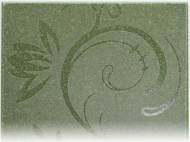Bio-tiles and heat-resistant bioplastic from polylactides (PLA)
 Researchers at the Fraunhofer Institute for Mechanics of Materials (Fraunhofer IWM) in Halle have designed organic tiles which are made of renewable raw materials. These bio-based tiles are more environmentally friendly, light-weight, and more resource- and energy-efficient compared to conventional ceramic materials. Aside being more resource-efficient, the new tiles unlock new creative solutions for designers.
Researchers at the Fraunhofer Institute for Mechanics of Materials (Fraunhofer IWM) in Halle have designed organic tiles which are made of renewable raw materials. These bio-based tiles are more environmentally friendly, light-weight, and more resource- and energy-efficient compared to conventional ceramic materials. Aside being more resource-efficient, the new tiles unlock new creative solutions for designers.
Bioplastics made of polylactides (PLA) are a form of plastics derived from renewable biomass sources, such as corn starch, pea starch or vegetable fats and oils. The packaging industry is increasingly using bioplastic made from PLAs since it is more environmentally friendly than petroleum-based plastic. The problem PLA had is the fact it begins to soften at about 60ºC (140ºF), so it couldn’t be used in heat-intensive processes.
Researchers at the Fraunhofer Institute for Applied Polymer Research (Fraunhofer IAP) in Potsdam have found a way to make PLA stereo complexes – a variation of PLA bioplastic which is more heat-resistant, and therefore, more applicable. PLA stereo complexes retain their shape and remain stable even at temperatures of up to 120ºC (248ºF).
“To make PLA plastics more form-stable at higher temperatures, we introduced stereo complexes with special components of L-lactides and D-lactides. These right-and-left rotating molecules complement each other and make the bond even more stable”, said Dr. Johannes Ganster, division director at Fraunhofer IAP.
Aside enabling the material to be used in high-temperature filling processes in the food industry, the researchers at the Fraunhofer IWM envision that this technology could be used for a twist in production of architectural elements. In the molding process, the material can be shaped on an entirely customized basis into any shape the mold allows. Even patterns and colors can be tailor-made.
The composite is not hard as glass and brittle like conventional epoxy, but flexible and easier to work with. It consists of a mixture of linseed oil epoxy, various natural fibers and diatomaceous earth (a material that is procured from fossilized diatoms). By adding fluorescent pigments to the blend, they are transformed into light tiles that can be used both outdoors and indoors as illuminated guideposts on floors and walls. The same bio-tiles can also be installed in kitchens and bathrooms and can serve as indoor floor coverings.
PLAs have become as durable and sturdy as any petroleum-based plastic, but they can be easily composted, and are ideal for recycling by decomposition in lactic acid. PLAs could find wide use in protective films, computer housing, shopping bags, as well as in architecture. Fraunhofer IAP researchers are working closely with a German factory builder that intends to incorporate the new process into its business operations.









Leave your response!